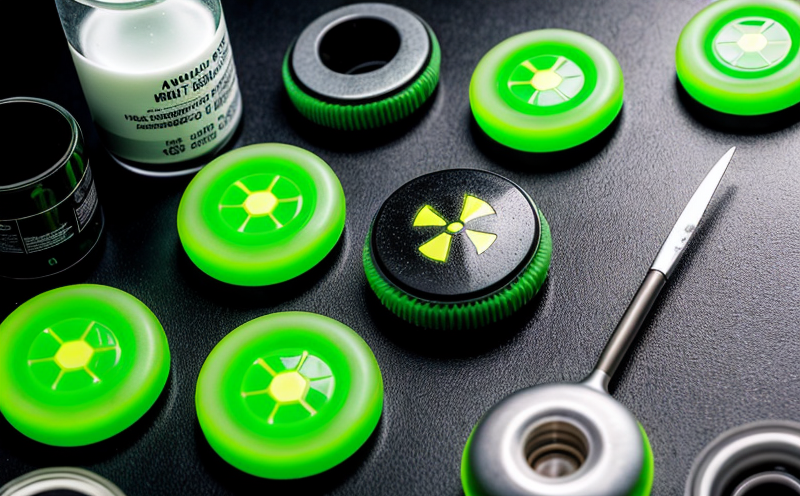AOAC 996.06 Radiocesium Detection in Food Matrices
The AOAC 996.06 method is a widely recognized standard for the detection of radiocesium isotopes, particularly 134-Cs and 137-Cs, in various food matrices. This method is crucial for ensuring the safety and quality of food products by identifying potential contamination from nuclear fallout or other sources. The procedure involves several critical steps that ensure accurate and precise results.
The first step in this process is the preparation of the sample, which can vary depending on the matrix type. For solid foods such as grains, legumes, or leafy vegetables, the sample must be homogenized to ensure uniformity. Liquid samples like milk or fruit juices are typically filtered and diluted if necessary. It's important that the sample preparation is done in a controlled environment to prevent contamination.
The detection method itself relies on liquid scintillation counting (LSC), which involves dissolving the prepared sample and then mixing it with a scintillant solution. The mixture emits light when exposed to radiation, allowing for quantification of the radiocesium isotopes present. This step is critical as it directly impacts the accuracy of the final results.
The next phase involves calibration using reference materials that are traceable to national standards. This ensures consistency and reliability across all tests conducted by our laboratory. Once calibrated, the samples are analyzed under controlled conditions in a dedicated gamma counting room. The use of high-purity germanium (HPGe) detectors is essential for achieving low detection limits.
Quality control measures are also integral to this process. Each batch of samples undergoes internal checks and cross-references with historical data to ensure consistency and accuracy. External audits conducted by independent bodies further validate our methods and results, providing additional assurance to our clients.
The final step is the interpretation and reporting of the results. Our team uses advanced software to analyze the data collected during the counting process. This analysis helps determine whether the levels of radiocesium isotopes exceed acceptable limits set by regulatory authorities such as the World Health Organization (WHO) or the European Food Safety Authority (EFSA).
By adhering strictly to the AOAC 996.06 protocol, we ensure that our clients receive reliable and accurate data on their food products' radiocesium content. This is particularly important for companies involved in international trade where regulatory compliance is paramount.
Applied Standards
The AOAC 996.06 method aligns with several internationally recognized standards, including ISO and ASTM. These include:
- ISO 3696:2016 - General Principles for the Determination of Radioactivity in Foodstuffs.
- ASTM E1777-14 - Standard Practice for Determining Specific Activity of Short-Lived Radionuclides by Liquid Scintillation Counting.
The use of these standards ensures that our laboratory remains at the forefront of food safety and quality assurance practices. Our adherence to such rigorous protocols guarantees reliable results, which are essential for maintaining compliance with international regulatory requirements.
Eurolab Advantages
Our laboratory is a member of Eurolab, an association that promotes excellence in conformity assessment. As part of this prestigious group, we offer several advantages to our clients:
- Accreditation: We are fully accredited according to ISO/IEC 17025:2017 standards.
- Expertise: Our team consists of highly trained professionals with extensive experience in food safety and quality assurance.
- Technology: Equipped with state-of-the-art equipment, including HPGe detectors and liquid scintillation counters.
- Consistency: Robust quality control measures ensure consistent results across all tests.
- Compliance: We stay up-to-date with the latest regulatory requirements and provide guidance on compliance strategies.
- Client Satisfaction: Our commitment to excellence in service delivery leads to high client satisfaction rates.
These advantages position us as a trusted partner for food safety testing, ensuring that our clients can rely on accurate and reliable results every time.
Customer Impact and Satisfaction
Our laboratory plays a crucial role in supporting the quality management processes of our clients. By providing accurate radiocesium detection, we help ensure that food products meet stringent safety standards set by regulatory bodies like the WHO and EFSA.
The AOAC 996.06 method is particularly beneficial for companies involved in international trade, where compliance with global regulations is essential. Our detailed reports not only assist in meeting these regulatory requirements but also provide valuable insights into potential risks associated with radiocesium contamination.
Moreover, our commitment to excellence extends beyond just detection; we offer comprehensive support throughout the testing process. From sample preparation to result interpretation, our team ensures that clients receive clear and actionable information. This proactive approach enhances overall customer satisfaction and helps build long-term relationships based on trust and reliability.





